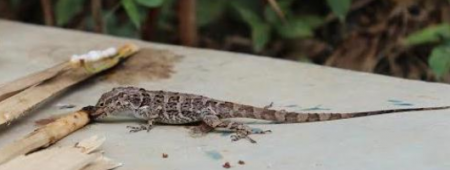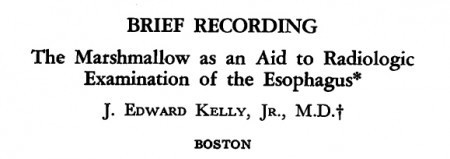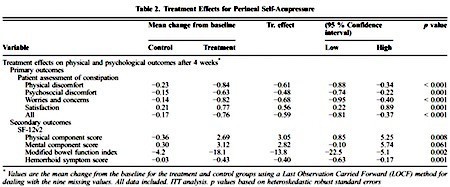Marc Abrahams's Blog, page 350
January 25, 2015
“Gay bomb” research facility urges caution about “love hormone”
 The laboratory facility that long ago won honors for doing research and development on the so-called “gay bomb” is casting a skeptical eye at widespread claims about oxytocin, a substance some people call “the love hormone”.
The laboratory facility that long ago won honors for doing research and development on the so-called “gay bomb” is casting a skeptical eye at widespread claims about oxytocin, a substance some people call “the love hormone”.
The Neuroskeptic blog reports:
A new study offers two reasons to be cautious about some of the claims made for the role of the hormone oxytocin in human behavior.
The paper’s out now in PLoS ONE from researchers James C. Christensen and colleagues, who are based at the US Air Force Research Laboratory in Ohio. That the military are interested in oxytocin at all is perhaps a testament to the huge amount of interest that this molecule has attracted in recent years. Oxytocin has been called the “hug hormone”, and is said to be involved in such nice things as love and trust. But according to Christensen et al., quite a lot of previous oxytocin research may be flawed.…
The 2007 Ig Nobel peace prize was awarded to the Air Force Wright Laboratory, Dayton, Ohio, USA, for instigating research & development on a chemical weapon — the so-called “gay bomb” — that will make enemy soldiers become sexually irresistible to each other.
REFERENCE: “Harassing, Annoying, and ‘Bad Guy’ Identifying Chemicals,” Wright Laboratory, WL/FIVR, Wright Patterson Air Force Base, Ohio, June 1, 1994.
BONUS: James C. Christensen [pictured below] also is part of a team that says: “We did something that has never been done before. Modifying a car—a 2014 Corvette C7 Stingray—so a qualified quadriplegic driver can safely operate it under racetrack conditions. We call it SAM. A semi-autonomous motorcar.”
January 24, 2015
Behold the evasive leap behavior of a spooked squirrel
“This video shows a series of clips of ground squirrels responding to a spring-loaded device that uncoils toward them at the same velocity at which rattlesnakes strike,” writes Rulon Clark of San Diego State University.
Clark adds:
All responses are shown slowed down to one-quarter regular speed. Squirrels either scrambled away from the spring (first set of clips in video), or exhibited an evasive leap, jumping into the air and contorting their bodies with the tail (second set of clips). Squirrels that had recently interacted with rattlesnakes at that site, and that exhibited tail flagging signals, responded more quickly to the device, and were more likely to exhibit an evasive leap than a scramble.
Further details are at his web site, and in the study “The fear of unseen predators: ground squirrel tail flagging in the absence of snakes signals vigilance“, Breanna J. Putman and Rulon W. Clark, Behavioral Ecology, epub 2014.
Also see Susan Milius’s essay about this, in Science News: “Why ground squirrels go ninja over nothing“
A dance of the slime molds
Tchaikovsky and Science In Seconds and some slime molds team up, sort of, to present this pasticcio performance:
BONUS: Slime mold delights, for bread enthusiasts
January 23, 2015
The Bowler Hat as a banking icon
How has the Bowler Hat featured as part of the iconography of the banking industry? For answers, turn to Jane Davison, BA (Liverpool), MA, PhD (London), FCA, FHEA, who is Professor of Accounting at the Royal Holloway, University of London. The professor’s paper on the subject ‘Icon, iconography, iconology Visual branding, banking and the case of the bowler hat’ was published in the Accounting, Auditing & Accountability Journal, Vol. 22 No. 6, 2009 pp. 883-906, and focuses attention on the use of the bowler icon by (what was) the UK’s Bradford & Bingley financial institution.
“
The financial statements are almost silent regarding brands, in line with regulation. In response to the greater competition that accompanied deregulation and globalisation, the Bank’s lending and funding practices become more innovative. The visual framework reveals a changing iconography and iconology where class, detectives, music hall and the bowler-object may be discerned. An iconology is suggested of dreamlike connotations and magical powers in the collective unconscious. The Bradford & Bingley have actively managed their visual branding to reflect and appeal to a changing society, and a more competitive business environment.”
Notes: Bradford & Bingley was “taken into public ownership” (viz. rescued by the Bank of England) after the company’s share price fell to £0.20 in Sep. 2008.
It had previously registered the UK trademark which depicted four bowler hats blowing away in the wind (UK2168259). B&B also owned what was said to be Stan Laurel’s bowler hat, which it had reportedly purchased for £2,000 in 1995, and which was displayed at their offices.
Improbable has not been able to verify the current location of the hat.
January 22, 2015
The Self-Acupressure-to-Overcome-Constipation Experiment
There is (people say) more than one way to skin a cat. So too are there multiple ways to overcome constipation. Here’s a newly documented way:
“Effect of Perineal Self-Acupressure on Constipation: A Randomized Controlled Trial,” Ryan Abbott, Ian Ayres [pictured below], Ed Hui, and Ka-Kit Hui, Journal of General Internal Medicine, 2014, pp. 1-6. (Thanks to investigator Toby Sommer for bringing this to our attention. The authors, at the University of California, Los Angeles and at Southwestern Law School, Los Angeles, report :
“We aimed to evaluate whether perineal self-acupressure would improve patient reports of quality of life and bowel function at 4 weeks after training…. Among patients with constipation, perineal self-acupressure improves self-reported assessments of quality of life, bowel function, and health and well-being relative to providing standard constipation treatment options alone.”
Here’s further detail from the study:
Here’s an appreciative writeup in the Yale Alumni Magazine:
A law professor’s theory about relieving constipation is put to the test
By Carole Bass | Jan/Feb 2015Some 20 years ago, Ian Ayres ’81, ’86JD, discovered a better way to poop. Recently, he decided to share it with the world. So the Yale law professor and an alumnus, Ryan Abbott ’11JD, collaborated on a constipation study. We’re relieved to report that it came out all right.
How did two law professors undertake a randomized, controlled medical trial and publish it in a scientific journal? It helps that one (Abbott, who teaches at Southwestern Law School) is also a physician and visiting assistant professor of medicine at the University of California–Los Angeles, where he conducted the study. It also helps that Ayres is, in his words, “committed to turning my annoyances into publications.…”
This is a photo of law professor, and co-author of the study, Ian Ayres:
BONUS: This is Screamin’ Jay Hawkins performing the song “Constipation Blues”:
January 21, 2015
Originally considered an insult
“Regularly Ig Nobel awards ceremony for the curious scientific studies were originally considered an insult, today they mostly proudly awards (recently including our domestic scientists). Analysis of mortality individual chess pieces and related research by this award could aspire too.”
—from the article “Kdo přežije?” in the January 12, 2015 issue of Hospodářské Noviny, [machine-translated by Google, from the original Czech]
Smelling bodies at the office (corporeal porosity)
As Dr. David Abram wrote in his 1996 book ‘The Spell of the Sensuous’ :
“[…] the boundaries of a living body are open and indeterminate: more like membranes than barriers … so that it is very difficult to discern, at any moment, precisely where this living body begins and where it ends.”

 Such indeterminacies have prompted Professor Kathleen Riach [pictured left] (Monash University, Australia) and Professor Samantha Warren [pictured right] (University of Essex, UK) to investigate what impact such ‘corporeal porosity’ might have in a white-collar office environment. Specifically via ‘corporeal seeping and secretion’ which lead, perhaps inevitably, to smells. Their paper on the subject will appear in a forthcoming print issue of the journal Human Relations. ‘Smell organization: Bodies and corporeal porosity in office work’
Such indeterminacies have prompted Professor Kathleen Riach [pictured left] (Monash University, Australia) and Professor Samantha Warren [pictured right] (University of Essex, UK) to investigate what impact such ‘corporeal porosity’ might have in a white-collar office environment. Specifically via ‘corporeal seeping and secretion’ which lead, perhaps inevitably, to smells. Their paper on the subject will appear in a forthcoming print issue of the journal Human Relations. ‘Smell organization: Bodies and corporeal porosity in office work’
“This article contributes to a sensory equilibrium in studies of workplace life through a qualitative study of everyday smells in UK offices. Drawing on Csordas’ (2008) phenomenology of intercorporeality, we develop the concept of corporeal porosity as a way of articulating the negotiation of bodily integrity in organizational experience. We explore the corporeal porosity of workplace life through smell-orientated interview and diary-based methods and our findings highlight the interdependence of shared, personal, local and cultural elementals when experiencing smell in office-based work. Our analysis explores three elements of bodily integrity: ‘cultural permeability’; ‘locating smell in-between’; and ‘sensual signifiers’. This suggests that while the senses are part of the ephemeral, affective ‘glue’ that floats between and around working bodies, they also foreground the constantly active character of relationality in organizational life. Corporeal porosity, therefore, captures the entanglement of embodied traces and fragments – corporeal seeping and secretion that has hitherto taken a backseat in organizational studies of the body at work.”
For their project, the team conducted a series of ‘smell interviews’ with 14 ‘fairly typical’ UK office-workers.
“After piloting a variety of techniques using postgraduate student volunteers, we finalized a three stage design: (1) videotaped ‘smell interviews’ (average length 62 minutes) that began with initial dialogue about participants’ experience of smell at work followed by a more focused discussion using mouliettes (paper strips) impregnated with ‘office smells’ such as coffee, sweat and office furniture; (2) audio smell diaries, recorded over a period of one working week whenever the participant encountered a ‘smell episode’ they wished to note (average of nine entries per participant); (3) a second round of face-to-face interviews (digitally recorded, average 55 minutes) where individuals further discussed their diary entries alongside pictorial representations of their workspaces.”
The interviews (un)covered experiences of both nice aromas (coffee, perfume etc.) and not-so-nice (men’s toilets etc.). And, in (the) conclusion :
“Exploring one phenomenon – smell – helps to consider the moving, dynamic, lived experience of work as not only intersubjective but a negotiation of the material and ontological boundaries of our existence. The inherent and inevitable reciprocity of feelings and actions are always inhaled through, within and across bodies and subsequently craft work experience.”
Also see: [aroma related Improbable notes]
Fishy smells (psychological effects of)
“Should Mary Smell Like Biscuit?”
Verbal Smell References In Radio Advertisements
The Marshmallow, in herpetology and medicine
 The 390 species of Anolis-lizards are generally considered insectivorous. Some also eat fruit and nectar. Recently, a new source of food for these New World reptiles was discovered: On the Consumption of Marshmallow Residues, an Atypical Food Item, by Anolis cristatellus Duméril and Bibron, 1837 in Puerto Rico [LEB (Life: The Excitement of Biology) 2: 270-271, January 10, 2015]
The 390 species of Anolis-lizards are generally considered insectivorous. Some also eat fruit and nectar. Recently, a new source of food for these New World reptiles was discovered: On the Consumption of Marshmallow Residues, an Atypical Food Item, by Anolis cristatellus Duméril and Bibron, 1837 in Puerto Rico [LEB (Life: The Excitement of Biology) 2: 270-271, January 10, 2015]
Norman Greenhawk, of Tropic Ventures Research and Education Foundation, Las Casas de la Selva, Buzón, Puerto Rico, reports:
On March 18th, 2014, at approximately 09:00, I observed an adult male Anolis cristatellus eating the remains of a marshmallow that had been roasted over a campfire the night before. The remains were on the end of stick that had been discarded on an outdoor table at the homestead of Las Casas de la Selva, a sustainable forestry project in the Carite Forest region of Patillas, Puerto Rico. The anole licked the charred marshmallow residue and four times bit the end of the stick. This feeding event took place for eleven minutes, until one of the observers accidentally startled the anole.
The author concludes:
I believe this is the first record of an anole consuming a human-manufactured food item.
Please note that consumption of marshmallows by other – even carnivorous – reptiles is well-known in Florida and Louisiana:
BONUS: “The Marshmallow as an Aid to Radiologic Examination of the Esophagus” by J. Edward Kelly, Jr in New Engl J Med 1961; 265:1306-1307
January 20, 2015
Cured pork up the nose for riches, rather than for medical purposes
 One hesitates to inquire whether the new bacon-scented lottery tickets offered by the state of New Hampshire were inspired in any way by news photos of the Ig Nobel Prize-winning study “Nasal Packing With Strips of Cured Pork as Treatment for Uncontrollable Epistaxis in a Patient with Glanzmann Thrombasthenia.”
One hesitates to inquire whether the new bacon-scented lottery tickets offered by the state of New Hampshire were inspired in any way by news photos of the Ig Nobel Prize-winning study “Nasal Packing With Strips of Cured Pork as Treatment for Uncontrollable Epistaxis in a Patient with Glanzmann Thrombasthenia.”
New Hampshire’s lottery offers this deal (and, on its web site, suggests the odds of losing):
Scratch-n-Sniff Bacon Scented Ticket!
Reveal a “HEART” symbol, win prize shown.
Reveal a “BACON” symbol, win DOUBLE the prize shown.
$1 – I Heart Bacon
Top Prize: $1,000
On Sale: 01/05/2015
The medical study was written by Ian Humphreys, Sonal Saraiya, Walter Belenky and James Dworkin, and published in Annals of Otology, Rhinology and Laryngology, vol. 120, no. 11, November 2011, pp. 732-36. Co-authors Ian Humphreys, Sonal Saraiya, Walter Belenky and James Dworkin, were awarded the 2014 Ig Nobel Prize for medicine, for treating “uncontrollable” nosebleeds, using the method of nasal-packing-with-strips-of-cured-pork.
(Thanks to Scott Langill for bringing the lottery tickets to our attention.)
Kiwis and the sensible quest against toppling
Richard Lehman writes (in his journal reviews column, in BMJ), about a standout article about standing up for standing up, in The Lancet:
I do wish the world was run by New Zealanders. Unassumingly tough, kind and sensible, uninterested in adopting other people’s bad habits and neuroses, they are just wonderful at getting on with life. When old Kiwis have falls, they look at what they might fall over and what they might hold on to. Result: “a 26% reduction in the rate of injuries caused by falls at home per year exposed to the intervention.” OK, this has been done before. But it needs doing a lot more.
The New Zealand attitude about preventing falls shines also in the study that earned the 201o Ig Nobel Prize for physics:
2010 IG NOBEL PHYSICS PRIZE: Lianne Parkin [pictured here], Sheila Williams, and Patricia Priest of the University of Otago, New Zealand, for demonstrating that, on icy footpaths in wintertime, people slip and fall less often if they wear socks on the outside of their shoes.
REFERENCE: “Preventing Winter Falls: A Randomised Controlled Trial of a Novel Intervention,” Lianne Parkin, Sheila Williams, and Patricia Priest, New Zealand Medical Journal. vol. 122, no, 1298, July 3, 2009, pp. 31-8.
BONUS (somewhat related): Toppling of the Pops: A sometimes fatal quest for soda pop
Marc Abrahams's Blog
- Marc Abrahams's profile
- 14 followers







